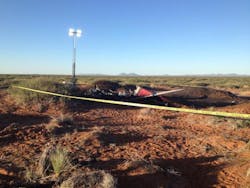The NTSB released its preliminary report on the Aug. 27 crash of a Cessna 421C just after takeoff from Las Cruces International Airport, New Mexico. The aircraft was on an air ambulance flight at the time of the accident; all four people on board were killed, including the pilot, the patient and two medical crewmembers.
The preliminary report concludes that the airplane was fueled with 40 gallons of Jet A (20 gallons in each tank) instead of 100LL avgas. The NTSB has not yet made any determination whether the misfueling was the cause of the accident. But the report contains clues that indicate the misfueling may well have been a likely cause.
Specifically, the report states that one of the medical crewmembers called their dispatch and reported the flight was turning back because “of a problem with smoke coming from the right engine.” An eyewitness on the ground reported to NTSB investigators that he saw smoke coming from the right engine as the aircraft climbed to about 200 feet AGL. Another witness reported that the aircraft “was trailing smoke”.
Jet fuel in a reciprocating engine will cause severe engine problems up to and including engine failure. The smoke seen coming from the right engine is a clear indicator that the engine was having problems.
While the NTSB investigation will make its probable cause determination in due course, this accident should serve as reminder of the importance of following proper procedures to ensure that each and every aircraft is correctly fueled regardless of whether misfueling ends up being the cause of the crash.



